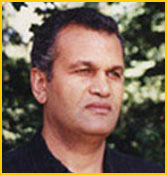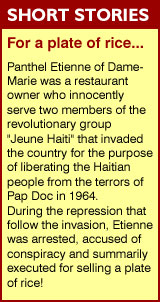| Home| The Chronicle | The Book | List of Victims | Guestbook Entries | Email us | Recent Additions |Past Honorees | ||||||||||
|
||||||||||
 THE GALLERIES ALSO
|
||||||||||
|
Book
Review published in CARIBNEWS |
Next | |||||||||
| Fort-Dimanche,
Dungeon of Death tells the awful story of a young man who
survives a death to which he has been sentenced in the terrible
physical and psychological condition in the native Haiti. |
And
they do so in the way that all oppressors do: with intimidation,
with deprivation of
human essentials of food, air, water, light medical care and
privacy. Indeed the detainees are stripped off their individualism
and their hope in preparation for the inevitable sentence of
death at the hands of imprisoners. But the conditions take their toll on the prisoners and Lemoine too succombs to the ravages of sickness brought on by the notorious conditions. As mysteriously as they were entrapped, so too are they released after 5 years of imprisonment. Lemoine and friend, Seraphin are returned to a more humane condition at Casernes Dessalines. Here they are given some basic creature comforts:better food, a toothbrush and medical attention. And with the election of a new president in the United States in the person of Jimmy Carter, |
there appears to be hope of real relief. Freedom comes as unexpectedly as it was taken away as Lemoine and friend are released to their famiies. After a brief exile in Jamaica, Lemoine is finally able to go to New-York where he is reunited with his mother and his ordeal comes to a close. But the
memory of the time lost, and the friends and other prisoners
who did not share his good fortune to emurge alive from the
dungeons of the oppressive political sytem is what this book
is about. Lemoine vows, like others before him, not to forget
the heroes who did not survive the awful pain and suffering
of Fort-Dimanche. |
||||||||
| |
||||||||||
| It is nice to
know that your website reminds of us that our family members did
not die in vain! (Melissa M. Poux- Aug 29, 2007) |
||||||||||
| Copyright
© 2002 Fordi9.com. All rights reserved. |
||||||||||


